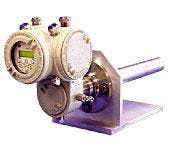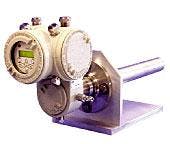New flue gas oxygen analyzer self-calibrating
OxyTrak, an in situ flue gas oxygen analyzer, is self-calibrating and requires no reference air.
The sealed reference analyzer uses a miniaturized zirconium-oxide sensor with a sealed internal reference to determine flue gas oxygen content accurately, even with rapidly changing process conditions.
With the sensor acting in pump mode, the current needed to maintain partial pressure equilibrium is proportional to the oxygen content. In addition, the Nernst voltage present during transients is used to indicate the magnitude of oxygen content changes instantly. The small sensor size allows the measurement inputs to reach equilibrium quickly, providing good speed of response.
The unit is designed for in situ installations with variable probe lengths up to 60 in.
The microprocessor-based electronics package features an infrared, through-the-glass key pad; a universal power supply (85-264 v AC); 0/4 to 20 ma or 0-2 v DC analog output; dual alarms; a fail-safe alarm; and an RS232 or RS485 serial output.
Because OxyTrak does not require routine calibration, it’s easy to maintain and to use-particularly since it is most often mounted on hard-to-reach stacks, the company notes.
Source: GE Infrastructure Sensing, 1100 Technology Park Drive, Billerica, MA 01821.
New flow computers for remote wellsites
Three new products, which comprise the ControlWave flow computer family, help to automate remote gas wellsites and meter stations.
Units combine the integration benefits of flow computers with the I/O selections, 32-bit processing platform, and multitasking software environment.
Standard applications software and menu systems provide turnkey solutions for sites using as many as four meter runs. The ControlWave EFM can automate a four-run metering and regulating station or a complete wellsite. This unit integrates a ControlWave Micro RTU chassis as well as smart, DP/P/T transducers, modem, or radio and solar power system. The RTU chassis provides flexibility in I/O selections, and the package is approved for Class I, Division 2 hazardous areas.
The more compact GFC is a chart replacement but expands to automate a two-run metering and regulating station or wellsite processes such as plunger lift. The GFC is available in Class I, Division 1/intrinsically safe or Class I, Division 2 configurations.
ControlWave XFC uses an explosionproof, transmitter-style package to meet Class I, Division 1 requirements. This product operates effectively as a chart replacement, plunger lift controller, or two-run flow computer, the firm points out.
Source: Bristol Babcock Inc., 1100 Buckingham St., Watertown, CT 06795.






